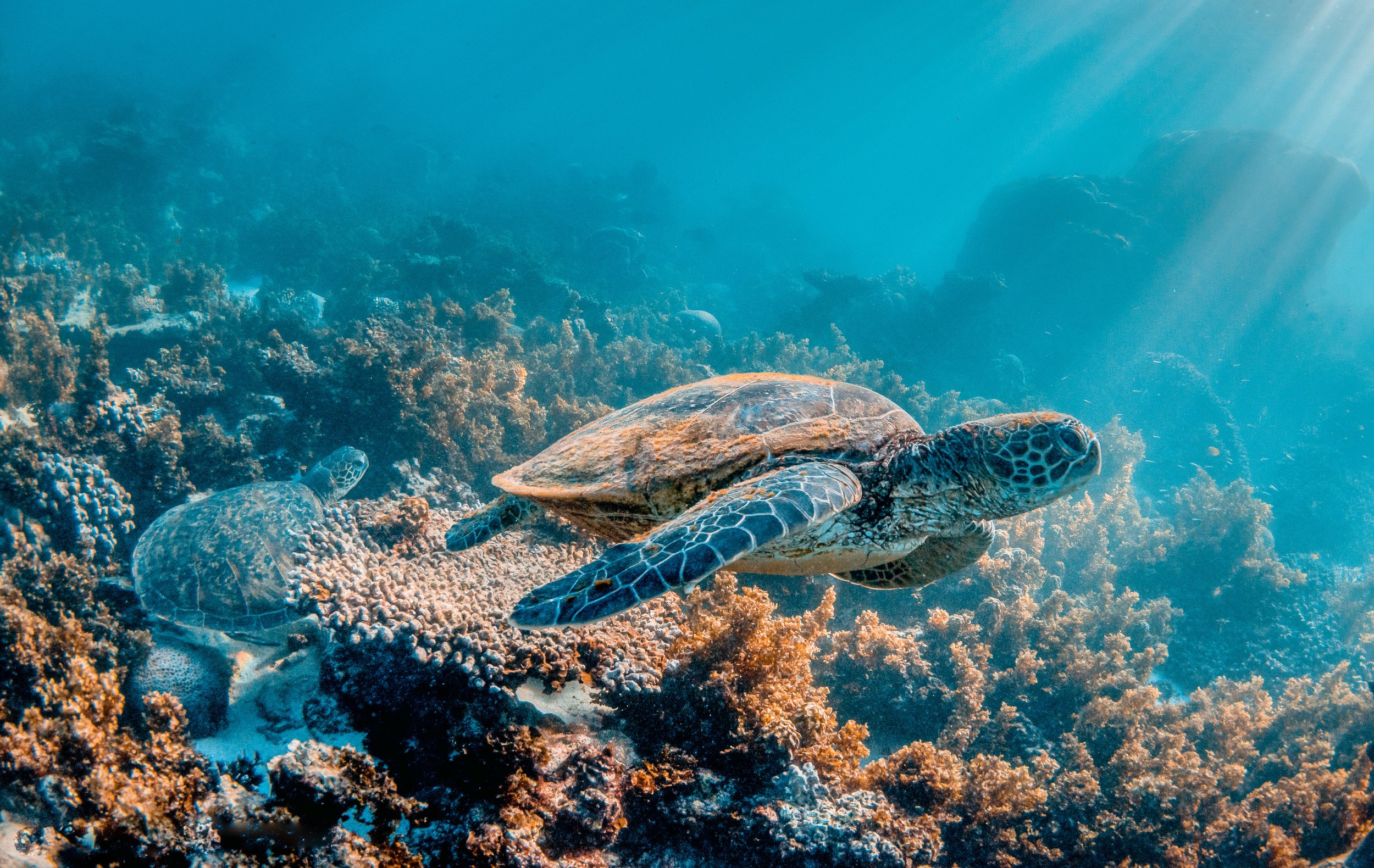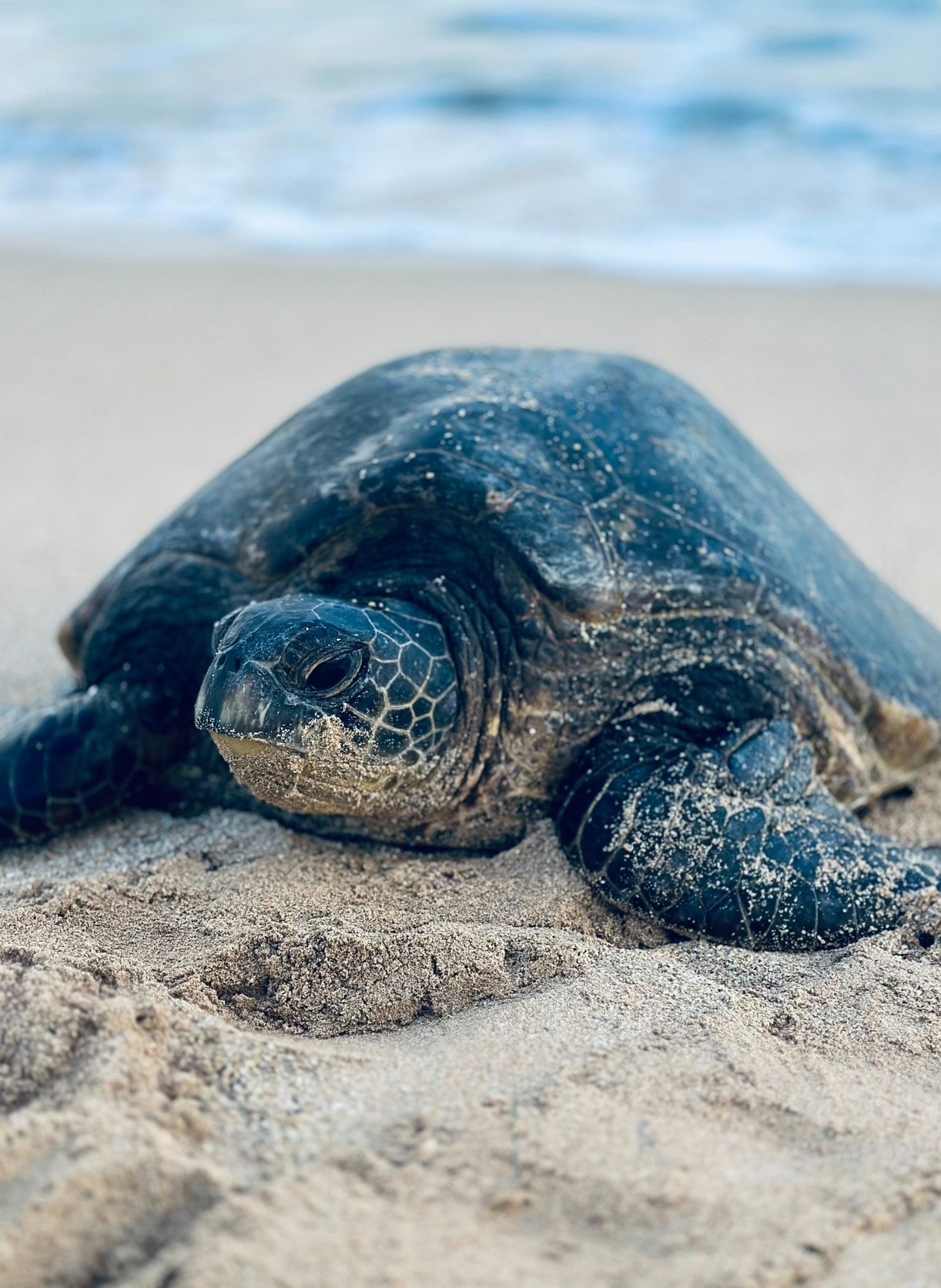
Sea Turtle Basics
Sea turtles are marine reptiles found in oceans worldwide, known fortheir fascinating behaviors and significant ecological roles. These gentle giants help maintain seagrass beds, coral reefs, and marine food chains which are essential to ocean health.
There are 7 species of sea turtles found world-wide (see table below). Four of these species have been found nesting on the beaches of the N.E.S.T. region of the Northern Outer Banks of North Carolina.
Loggerheads are the most common, followed by green, an occasional Kemp’s Ridley and a rare leatherback.
Sea turtles belong to two families: Cheloniidae (hard-shelled turtles) and Dermochelyidae (leatherbacks).
Sea turtles are reptiles – they breathe air, are cold blooded and lay eggsThey breathe air but spend most of their lives in the water.
Sea turtles are deep divers and can stay underwater for hours at a time. They even sleep underwater!
Sea turtles have flippers, not legs or claws
If healthy, they only come ashore to nest (except for Pacific greens who leave the ocean to sun-bathe)
Learn more about how NEST supports rescue and rehab of sea turtles:
Monitoring nest temperatures
Monitoring nest activity with hydrophones
Species of Sea Turtles
There are seven species of sea turtles, each with unique characteristics.
| Species | Scientific Name | Lifespan | Diet | Habitat | Size & Weight |
|---|---|---|---|---|---|
| Green | Chelonia mydas | 70+ years | Seagrasses and algae | Tropical and subtropical waters | 31-47 in, 265-485 lbs |
| Loggerhead | Caretta caretta | 50+ years | Jellies, sponges, bottom dwelling invertebrates | Tropical and subtropical waters | 31-43 in, 150-375 lbs |
| Leatherback | Dermochelys coriacea | 30+ years | Jellyfish, bottom dwelling invertebrates | All oceans and coastal waters | 50-60 in, 750-800 lbs |
| Hawksbill | Eretmochelys imbricata | 30+ years | Sponges, bottom dwelling invertebrates | Tropical and subtropical waters | 30-35 in, 100-150 lbs |
| Kemp's Ridley | Lepidochelys kempii | 30+ years | Crabs, bottom dwelling invertebrates | Gulf of Mexico, warmer waters of the Atlantic | 24-28 in, 75-100 lbs |
| Olive Ridley | Lepidochelys olivacea | 50+ years | Mollusks, crustaceans | Subtropical Pacific, Atlantic, Indian oceans | 24-30 in, 70-100 lbs |
| Flatback | Natator depressus | 50+ years | Sea cucumbers, mollusks, jellyfish | Australia, New Guinea | 30-36 in, 180-200 lbs |

Nesting and Hatching
Sea turtles exhibit remarkable nesting behaviors, often returning to the same beaches where they hatched (a process called natal homing). In North Carolina, data indicates that returning female turtles lay their nests in an average 50 mile range.
Sea Turtle Nests
Construction: Females haul out of the water and dig holes a nest chamber in the sand using their flippers. Depending on species, there can be an average of 50 –200 eggs laid in each clutch.
Nesting Locations: Nests are laid on the beaches of each species habitat
Frequency: Females nest multiple times during a season, but only every 2-3 years.
Hatching Process
Incubation Period: 45–70+ days, depending on species and environmental factors.
Temperature's Role: Sex of the turtles is determined by the temperature of the nest. Higher sand temperatures yield more females, while cooler sands produce more males.
Survival Rate: Sea turtle hatchlings have a very low survival rate. It is estimated that only 1 in 1,000 hatchlings survives to adulthood.
Lifespan and Growth
Sea turtles have long lifespans, but their growth to adulthood is slow, with many species taking decades to. reach adulthood.
Hatchlings: After emerging from the nest, hatchlings make their way to the ocean and swim out to sea. They spend their early years in the open ocean.
Juveniles: Live near the surface of the deep oceans and are carried by currents, eventually transitioning to coastal habitats.
Adults: Mate predominately along migration routes between foraging and nesting areas. Females often return to nesting beaches where they hatched to lay their nests.
Biologists estimate a sea turtle’s age by size, although growth rates vary by species and environmental conditions.

Migration and Navigation
Sea turtles are incredible navigators, capable of crossing entire oceans using Earth’s magnetic field. Some leatherbacks, for example, migrate over 12,000 miles annually between feeding grounds and nesting beaches.
Threats to Sea Turtles
Sea turtles face natural and human action challenges at different stages of their lives.
Natural Threats
Predators like ghost crabs, birds, raccoons and foxes target eggs and hatchlings.
Some species of fish consume hatchlings after they enter the ocean
Tiger and bull sharks target juvenile and adult sea turtles
Human-Induced Threats
Bycatch: Accidental capture in fishing gear.
Coastal Development: Loss of nesting habitats.
Pollution: Plastic ingestion often proves fatal.
Climate Change: Rising temperatures skew sex ratios and affect food availability.
FAQs
-
Protecting turtle nests is crucial to ensuring the survival of sea turtles. Here are some ways you can help:
Respect nesting areas: Avoid disturbing marked turtle nesting sites on beaches.
Minimize artificial light: Bright lights can confuse hatchlings, leading them away from the ocean.
Keep beaches clean: Remove trash and debris, which can obstruct hatchlings’ journey to the water.
Report nests: Notify local wildlife organizations if you spot a turtle nest in an unprotected area.
Taking these steps not only safeguards turtle nests but also helps local conservation efforts thrive.
-
Sea turtles have varied diets depending on their species:
Green turtles: Primarily eat seagrasses and algae.
Leatherback turtles: Specialize in eating jellyfish.
Loggerheads: Consume crabs, clams, and other shelled creatures.
Hawksbills: Feed on sponges and other invertebrates found in coral reefs.
Kemp’s ridleys and olive ridleys: Enjoy a mix of crabs, shrimp, and other small marine creatures.
This diversity in diet highlights their critical role in maintaining healthy marine ecosystems.
-
Determining a sea turtle’s age can be challenging, but researchers use these methods:
Size and shell growth: Younger turtles grow rapidly, so their size can be a good indicator of age in the first few years.
Growth rings: Like trees, sea turtles develop growth rings on their shells and bones, which can be studied to estimate age.
Tagging and tracking: Sea turtles marked as hatchlings provide exact age data when recaptured later in life.
While these methods offer estimates, they are not always precise due to environmental and individual factors influencing growth.
-
Sea turtles typically live 50 to 70 years in the wild, though some species, like green and leatherback turtles, may live longer. Factors such as diet, predation, and environmental conditions play a significant role in their longevity. Conservation efforts to reduce threats like plastic pollution and habitat loss are essential for helping these creatures live full lives.
-
Sea turtle eggs generally take 45 to 70 days to hatch, depending on species and environmental factors like temperature. Warmer sands often speed up incubation but may result in more female hatchlings, while cooler sands produce more males. Protecting nests during this critical period ensures more hatchlings make it to the ocean.


